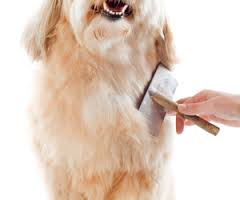|
Stop Dog Shedding
Shedding Tips for dog's owners

One of the biggest problems faced by pet owners is unwanted hair in their homes. Nearly every dog shed, regardless of their age or breed. Some breeds have more hair or thicker undercoats and will shed in higher quantities, but virtually all dogs will shed hair. While we cannot stop a dog from shedding, we can help reduce the amount of loose hair, and also effectively remove the hair so it doesn't create a problem in our homes. In general, most dogs will shed extra during Spring and Fall. Dogs are double-coated, meaning they have undercoats. These are secondary hairs that occur around the primary hairs and tend to be shorter and softer.
Seasonal dog shedding occurs as a result of temperature change. This process is often called "blowing coat." When the weather warms, dogs shed their old winter undercoats to make way for a lighter summer coat. Then, when it begins to get cool again, dogs shed their lighter undercoats and grow a thicker, warmer coat for winter. Not all coat types are affected the same way by temperature changes.
Your dog health can affect shedding rate, so it is important to take note of unexplained excessive shedding. Skin problems, endocrine diseases, nutritional or vitamin deficiencies, and other metabolic disorders can cause hair loss or change the rate of hair growth. It is important to contact your veterinarian if you are concerned about the rate of shedding in your dog. Keep your dog healthy with routine vet visits and contact your vet immediately if you notice any signs of illness. As a pet owner note that excessive dog shed can be prevented with proper nutrition.
How to stop dog shedding:
- Feed an appropriate food - A pet's coat is often a reflection of what they eat. Feed a high quality food with good digestible protein sources.
- Feed a fatty acid supplement - to your dog keeps his coat healthy.
- Control allergies and fleas - See your veterinarian to make sure your pet is getting proper allergy relief.
- Vacuum often - Be diligent in your vacuuming efforts. Frequent vacuuming is the best way to keep your home hair free.
- Bathe your dog occasionally during the summer - A clean dog will have a healthier coat. A gentle oatmeal shampoo once a week or so will clean without drying the skin and rejuvenate a lackluster hair coat.
- Have regular checkups - Many diseases can affect the skin and hair coat. Regular visits to your veterinarian will help identify problems early, and provide more effective treatment.
Excessive hair loss or bald patches may be due to one of the following:
- Parasites (fleas, lice or mites)
- Fungal or bacterial infections
- Inhalant or food-related allergies
- Kidney, liver, thyroid or adrenal disease (including Cushing’s)
- Pregnancy or lactation
- Certain medications
- Self-induced trauma due to licking
- Cancer
- Immune disease
- Sunburn
- Contact with irritating or caustic substances
In conclusion,
There's no way to completely stop dog shedding. It's a healthy process that is necessary for all dogs. Shaving your dog down is not a good idea, as it can interfere with your dog's natural self-cooling and self-warming mechanism. In the long run, it will not make shedding any less. The key to preventing the excess of your dog shed is to keep up with it. Routine grooming is absolutely essential. Brushing or combing your dog helps to remove dead hairs before they can fall on your carpet, bedding and upholstery.
It will prevent those dead hairs from forming mats on your dog's coat that can eventually harm the skin. Brushing also distributes the natural, healthy oils produced by the skin throughout the hair coat. Using the right grooming tools can make a great difference.
|